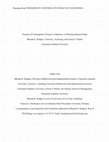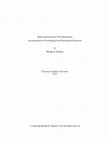Papers by Rhonda K Rodgers
Journal of Strategic Innovation and Sustainability, 2017

Organizational leaders and decision makers are searching for those who “do the right thing” regar... more Organizational leaders and decision makers are searching for those who “do the right thing” regardless of moral complexities or cultural norms. Researchers have categorized these individuals as mindful, authentic, etc., and suggest their more attentive, and less reactive nature enables them to maintain unique ways of seeing, thinking, and acting in the world. Interest is building in secular adaptations (e.g., mindfulness training) of teachings from antiquity (e.g., Buddhist mindfulness), however scarce attention has been given to practitioners. To address this lack of understanding about contemplative experiences, a phenomenological study was undertaken to explore contemplative practice as experienced by American businesspeople. Semi-structured interviews were conducted with executives, managers, and career professionals (n = 29) who had an ongoing contemplative practice at the turn of the last century, and follow up interviews were conducted 15 years later to explore the trajectory...
Leadership has been written about and studied for centuries, more often than not addressing how t... more Leadership has been written about and studied for centuries, more often than not addressing how those in leadership roles influence their followers. This represents a very leader-centric view of the leadership phenomenon, where followers are considered as passive recipients of leaders\u27 influence. However, people\u27s attempts to exercise leadership cannot be successful if there are no other people who recognize and support their leadership. In other words, effective leadership cannot exist without some form of followership - this book re-casts the \u27follower\u27 role in a more favourable and productive light
“Chapter 2… draws from work on Authentic Leadership to present a new theoretical perspective on A... more “Chapter 2… draws from work on Authentic Leadership to present a new theoretical perspective on Authentic Followers- Individuals who maintain an internalized moral perspective, heightened level of self-awareness and self-regulation, and are capable of developing an authentic relationship with the leader. The chapter explores characteristics of authentic followers, how leader and follower roles are fluid and interchangeable, and how authenticity is required by both leaders and followers to advance organizational objectives.” In: Followership What is it and Why do people follow? (Emerald Publishing, 2014)
As the study of followership further escalates into the global mainstream of leadership studies, ... more As the study of followership further escalates into the global mainstream of leadership studies, this book offers an excellent way to more proactively engage future leaders and followers in issues that they are likely to face in various organizational settings. Its business, education, and government content will appeal to academia, corporations, non-profits, and other enterprises
Followership in Action, 2016

MindRxiv Papers, 2020
Organizational leaders and decision makers are searching for those who “do the right thing” regar... more Organizational leaders and decision makers are searching for those who “do the right thing” regardless of moral complexities or cultural norms. Researchers have categorized these individuals as mindful, authentic, etc., and suggest their more attentive, and less reactive nature enables them to maintain unique ways of seeing, thinking, and acting in the world. Interest is building in secular adaptations (e.g., mindfulness training) of teachings from antiquity (e.g., Buddhist mindfulness), however scarce attention has been given to practitioners. To address this lack of understanding about contemplative experiences, a phenomenological study was undertaken to explore contemplative practice as experienced by American businesspeople. Semi-structured interviews were conducted with executives, managers, and career professionals (n = 29) who had an ongoing contemplative practice at the turn of the last century, and follow up interviews were conducted 15 years later to explore the trajectory of these individuals as professionals and contemplatives. At present (n = 7) of the original participants have been interviewed, and their experiences are the focus of this second wave of the study. The broad discovery is that over time, contemplative practice becomes an experiential framework for daily life, informing and influencing life choices in both personal and professional domains.

ProQuest Dissertations Publishing, 2019
Increasing stress levels and decreasing coping skills underlie a global epidemic, which is profou... more Increasing stress levels and decreasing coping skills underlie a global epidemic, which is profoundly impacting the health of humans and organizations. Current organizational stress interventions are theorized to influence health outcomes, but meta-analyses suggest otherwise. To effectively address this challenge, interventions must begin to target the root cause of stress related illness: the excessive human stress-response. This study is the second to explicate mental and emotional self-management (MESM), a mind-body strategy to address both psychological and physiological processes in the excessive stress-response. A pilot study (N =147) resulted in significant changes in mindful attention and well-being after three weeks. The present study advanced this inquiry by testing a one-week MESM intervention to determine efficacy in reducing psychological stress and attenuating physiological stress. Participants (N = 76) were healthy adults (between 18-30) assigned to one of three training conditions: psychological self-management, physiological nervous system regulation, or an active control group. Pre and posttest autonomic indicators of physiological stress (i.e., heart rate variability [HRV] and electrodermal activity) and self-report measures of psychological stress were analyzed to determine effectiveness of the MESM intervention and to guide future design.
Results of the study found no significant main effect of training on psychological measures or physiological measures, suggesting the one-week intervention was not effective in changing the stress response over time. However post hoc analysis revealed that when participants in the psychological self-management (PSM) group were prompted to begin breath counting during three minutes of skills practice, significant changes in HRV were measured, but this change was not sustained during the subsequent segment of laboratory stressor (i.e., video stimuli). Higher HRV is associated with more adaptive patterns of emotional self-regulation and resiliency to stress, and therefore indicates an adaptive physiological stress response (i.e., parasympathetic activation). Participants in the PSM group reported sharing their skills more frequently with others and utilizing these skills more frequently in daily life than participants in the physiological nervous system regulation group, and 48% of the PSM group reported breath counting meditation as the easiest skill to learn, supporting the premise that physiological changes in HRV during skills practice were attributable to breath counting meditation.
These results suggest that in the current intervention, HRV is responsive to breath counting, and therefore should be emphasized in future MESM interventions. However a longer intervention will be necessary to achieve sustainable changes in psychological and physiological reactivity to stress.
Keywords: organizational stress intervention, heart-rate variability, breath counting, self-management, excessive stress-response
Neuroscientists suggest that chronic stress diminishes cognitive ability, therefore rendering met... more Neuroscientists suggest that chronic stress diminishes cognitive ability, therefore rendering metacognitive exercises such as mindfulness training ineffective for many. An intervention was tested that incorporates tools to regulate the stress response prior to engaging metacognitive stress management techniques. A mixed-method study (N =147) compared business students with Amazon's mechanical Turkers. After three weeks of practice, trainees scored higher in mindful attention and well-being and training explained 16% of test score variance, suggesting a moderate to large effect size. This pilot study exposes a potential shortcoming in current forms of organizational mindfulness training and offers a solution for future intervention design.
“Chapter 2… draws from work on Authentic Leadership to present a new theoretical perspective on A... more “Chapter 2… draws from work on Authentic Leadership to present a new theoretical perspective on Authentic Followers- Individuals who maintain an internalized moral perspective, heightened level of self-awareness and self-regulation, and are capable of developing an authentic relationship with the leader. The chapter explores characteristics of authentic followers, how leader and follower roles are fluid and interchangeable, and how authenticity is required by both leaders and followers to advance organizational objectives.”
In: Followership What is it and Why do people follow? (Emerald Publishing, 2014)
Books by Rhonda K Rodgers
The specified objective of Followership in Action: Cases and Commentaries (Koonce, Bligh, Carsten... more The specified objective of Followership in Action: Cases and Commentaries (Koonce, Bligh, Carsten, & Hurwitz, Eds.) is to help students better understand the study of followership. Case studies with scholarly post-commentaries are presented which represent a wide variety of organizational behavior issues that apply to leaders and followers, and which can be categorized utilizing the leader-centric, follower-centric, relational, role-based, and constructionist framework of traditional followership research as modeled in Uhl Bien et al. (2014).

Uploads
Papers by Rhonda K Rodgers
Results of the study found no significant main effect of training on psychological measures or physiological measures, suggesting the one-week intervention was not effective in changing the stress response over time. However post hoc analysis revealed that when participants in the psychological self-management (PSM) group were prompted to begin breath counting during three minutes of skills practice, significant changes in HRV were measured, but this change was not sustained during the subsequent segment of laboratory stressor (i.e., video stimuli). Higher HRV is associated with more adaptive patterns of emotional self-regulation and resiliency to stress, and therefore indicates an adaptive physiological stress response (i.e., parasympathetic activation). Participants in the PSM group reported sharing their skills more frequently with others and utilizing these skills more frequently in daily life than participants in the physiological nervous system regulation group, and 48% of the PSM group reported breath counting meditation as the easiest skill to learn, supporting the premise that physiological changes in HRV during skills practice were attributable to breath counting meditation.
These results suggest that in the current intervention, HRV is responsive to breath counting, and therefore should be emphasized in future MESM interventions. However a longer intervention will be necessary to achieve sustainable changes in psychological and physiological reactivity to stress.
Keywords: organizational stress intervention, heart-rate variability, breath counting, self-management, excessive stress-response
In: Followership What is it and Why do people follow? (Emerald Publishing, 2014)
Books by Rhonda K Rodgers
Results of the study found no significant main effect of training on psychological measures or physiological measures, suggesting the one-week intervention was not effective in changing the stress response over time. However post hoc analysis revealed that when participants in the psychological self-management (PSM) group were prompted to begin breath counting during three minutes of skills practice, significant changes in HRV were measured, but this change was not sustained during the subsequent segment of laboratory stressor (i.e., video stimuli). Higher HRV is associated with more adaptive patterns of emotional self-regulation and resiliency to stress, and therefore indicates an adaptive physiological stress response (i.e., parasympathetic activation). Participants in the PSM group reported sharing their skills more frequently with others and utilizing these skills more frequently in daily life than participants in the physiological nervous system regulation group, and 48% of the PSM group reported breath counting meditation as the easiest skill to learn, supporting the premise that physiological changes in HRV during skills practice were attributable to breath counting meditation.
These results suggest that in the current intervention, HRV is responsive to breath counting, and therefore should be emphasized in future MESM interventions. However a longer intervention will be necessary to achieve sustainable changes in psychological and physiological reactivity to stress.
Keywords: organizational stress intervention, heart-rate variability, breath counting, self-management, excessive stress-response
In: Followership What is it and Why do people follow? (Emerald Publishing, 2014)